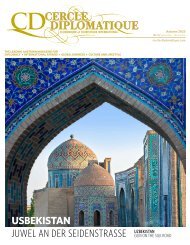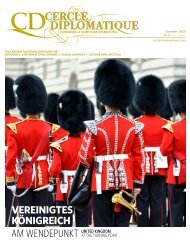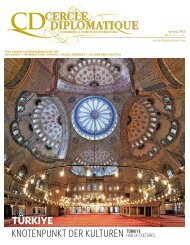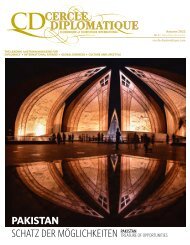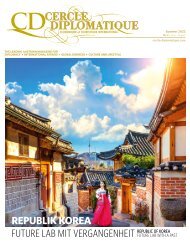CERCLE DIPLOMATIQUE - issue 02/2019
CD is an independent and impartial magazine and is the medium of communication between foreign representatives of international and UN-organisations based in Vienna and the Austrian political classes, business, culture and tourism. CD features up-to-date information about and for the diplomatic corps, international organisations, society, politics, business, tourism, fashion and culture. Furthermore CD introduces the new ambassadors in Austria and informs about designations, awards and top-events. Interviews with leading personalities, country reports from all over the world and the presentation of Austria as a host country complement the wide range oft he magazine.
CD is an independent and impartial magazine and is the medium of communication between foreign representatives of international and UN-organisations based in Vienna and the Austrian political classes, business, culture and tourism. CD features up-to-date information about and for the diplomatic corps, international organisations, society, politics, business, tourism, fashion and culture. Furthermore CD introduces the new ambassadors in Austria and informs about designations, awards and top-events. Interviews with leading personalities, country reports from all over the world and the presentation of Austria as a host country complement the wide range oft he magazine.
Create successful ePaper yourself
Turn your PDF publications into a flip-book with our unique Google optimized e-Paper software.
LE MONDE SWEDEN<br />
INFO<br />
Right: At a VOLVO<br />
construction site.<br />
Below: The Öresund<br />
Bridge is almost 8 km<br />
long and is linking<br />
Sweden with Denmark.<br />
Left: Top chef Magnus Nilsson,<br />
using moss and weaves in his<br />
dishes, is going to close his<br />
acclaimed restaurant Fäviken<br />
Magasinet.<br />
Innovation & Research<br />
Sweden’s long-term focus on education and<br />
research has also had a major impact on<br />
the capacity for innovation and became a<br />
vital component in Sweden’s journey from<br />
poor agricultural nation to prosperous<br />
innovation leader. Today, about one-third of<br />
the population has post-secondary<br />
education.<br />
When it comes to research and development<br />
(R&D), Sweden proves its commitment<br />
by investing, as a rule, more than<br />
3 per cent of the country’s GDP in R&D.<br />
Green technology and life sciences are two<br />
fields in which Swedish researchers and<br />
companies excel. The government has<br />
created an office of life sciences dedicated<br />
to developing a national strategy for the life<br />
sciences to further promote the field.<br />
From top: Graphene research in<br />
Gothenburg; The Kista Science<br />
City and a bus running on<br />
methane.<br />
Sweden is one of the world’s northernmost countries<br />
and sparsely populated, characterised by its<br />
long coastline, extensive forests and numerous lakes.<br />
With its variety of landscapes, Sweden has everything<br />
from bears and wolves in the north to deer<br />
and wild boar in the south. The country also has a<br />
wealth of flora and aquatic life, which contribute to<br />
its biological diversity and one experiences extreme<br />
contrasts between its long summer days and equally<br />
long winter nights.<br />
Sweden borders Norway to the west and north<br />
and Finland to the east, and is connected to Denmark<br />
in the southwest by a bridge-tunnel across the<br />
Öresund, a strait at the Swedish-Danish border. At<br />
450,295 square kilometres, Sweden is the largest<br />
country in Northern Europe and the third-largest<br />
country in the European Union. Sweden’s borders<br />
have been unchanged since 1905 and the country has<br />
not been at war since 1814 and has not been actively<br />
involved in World War II.<br />
Sweden has a long history of migration. But<br />
nothing has left a bigger mark on Sweden’s cultural<br />
landscape than the huge emigration of Swedes to the<br />
Americas and Australia from 1850 up until the<br />
1930s. As many as 1.5 million native Swedes left the<br />
country to escape poverty and religious persecution.<br />
On the other hand, e.g. in 1992, more than 84,000<br />
people, many of them fleeing the former Yugoslavia,<br />
requested asylum in Sweden. Also in recent years,<br />
the Swedish population grew. In 2014, this was the<br />
result of record high immigration (127,000; with the<br />
largest groups being Syrians and Eritreans) as well as<br />
more births than deaths. Changes in Swedish migration<br />
laws in 2015 are responsible now that asylum<br />
applications declined.<br />
Sweden is also preserving indigenous culture in<br />
the Arctic. The semi-nomadic Sami have been recognised<br />
by the United Nations as an indigenous<br />
people, giving them the right to preserve their crafts,<br />
language, education, reindeer husbandry, traditions<br />
and identity. Their population is estimated at around<br />
100,000 people, spread over Sweden, Norway, Finland<br />
and Russia.<br />
Sweden’s gross domestic product (GDP) per capita<br />
is among the highest in the EU, it has low inflation<br />
and a healthy banking system. But this has not always<br />
been the case. Historically, the Swedish economy<br />
suffered from low growth and high inflation, and<br />
the Swedish krona was repeatedly devalued. Sweden<br />
was also hit by a severe financial crisis in the early<br />
1990s. Banks became unstable and two were nationalised,<br />
unemployment rose sharply and government<br />
spending soared, as did national debt. The path<br />
back to stability and success was not easy for Sweden.<br />
Since the crisis of the 1990s, successive Swedish<br />
governments have succeeded in maintaining control<br />
PHOTOS: ADOBESTOCK, APELÖGÄ<br />
over public spending, and continued to do so even in<br />
the wake of the 2007–2008 global financial crisis by<br />
reinventing its economic governance with a series of<br />
innovative regulations. First, in 1996, a ceiling for<br />
public spending was introduced. This was accompanied<br />
by the addition of the ‘surplus goal’ for the<br />
government budget – measures that remain largely<br />
intact. These reforms were met with broad support<br />
from across the political spectrum in Sweden, where<br />
political consensus is often the norm. These measures<br />
help prevent the accumulation of debt, and ensure<br />
that the national debt is under surveillance.<br />
Today, Sweden has a diverse and highly competitive<br />
and successful economy. The World Economic<br />
Forum ranks Sweden among the top ten most competitive<br />
countries in the world. And Sweden is a land<br />
of world-renowned business icons. Ikea, for example,<br />
was already founded in 1943 in Sweden by then<br />
17-year-old Ingvar Kamprad and is a phenomenon<br />
that has changed the entire world's view of home furnishing.<br />
Nowadays the company’s seat is based in the<br />
Netherlands. The Swedish fashion chain H&M is<br />
also a huge global player. Much of its success is attributed<br />
to its wide selection of affordable fashion and<br />
ability to quickly pick up the latest trends.<br />
As iconic as Swedish meatballs, Volvo is the largest<br />
company in Sweden based on its annual turnover.<br />
The Chinese automotive manufacturing company<br />
Geely Holding Group bought a large share of AB<br />
Volvo – the part of the brand that mainly produces<br />
trucks, buses and construction equipment – in 2018<br />
and has owned Volvo Cars since 2010. First founded<br />
in 1927, the company is still headquartered in the<br />
Swedish city of Gothenburg. It is also putting strong<br />
emphasis on the innovative topics of automation and<br />
electromobility. Volvo Group has over 100,000 employees<br />
with production facilities in 18 countries<br />
worldwide and around 38,000 employees at Volvo<br />
Cars.<br />
Gender equality and the possibility of paternal<br />
leaves are an important <strong>issue</strong> in Sweden (see also the<br />
interview with Ambassador Mikaela Kumlin Granit,<br />
page 32). Yet, the business sector, on the other hand,<br />
is a heavily male-dominated field. In 2015, on the<br />
average board of a Swedish stock market company,<br />
almost one in three were women – a great increase<br />
compared with a few years earlier. In fact, if this development<br />
continues at the same pace, the boards of<br />
listed companies in Sweden will be gender-equal<br />
within ten years.<br />
From top:<br />
Colourful view of the old<br />
town in Stockholm;<br />
The city of Malmö with<br />
the Turning Torso Tower;<br />
Cool and stylish<br />
apartment buildings in<br />
Gothenburg.<br />
Living closely with<br />
nature: Staying at the<br />
Nyrups Naturhotell.<br />
28 Cercle Diplomatique 2/<strong>2019</strong><br />
Cercle Diplomatique 2/<strong>2019</strong><br />
29






